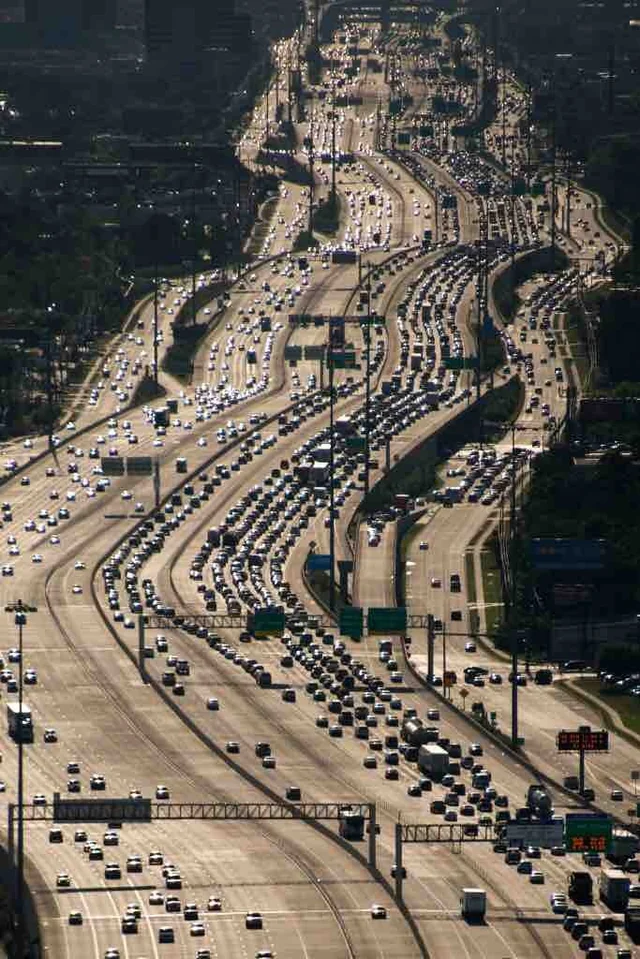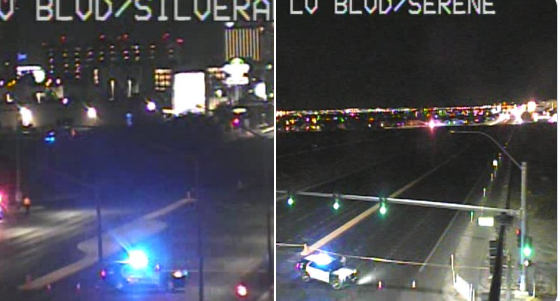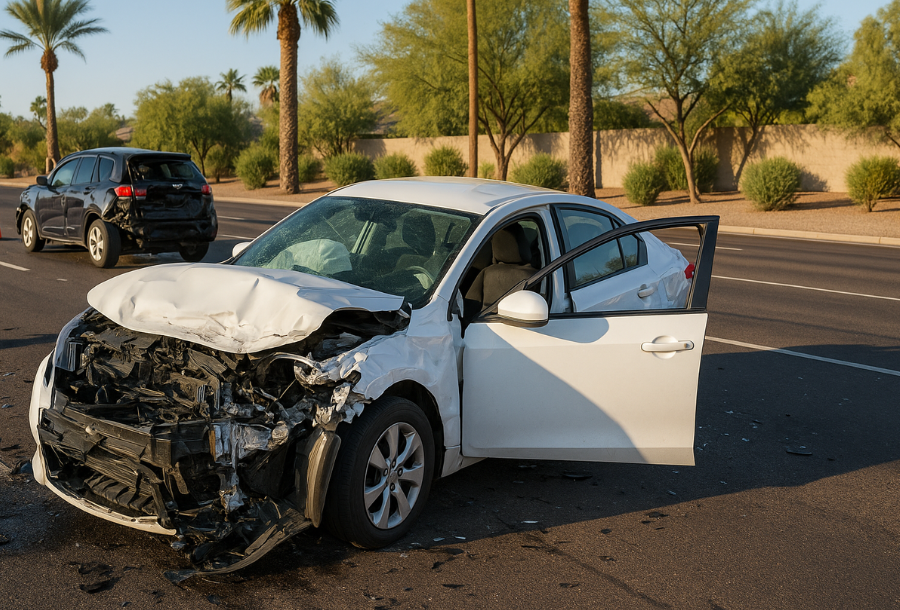HOUSTON, Texas — Traffic conditions on one of Houston’s busiest freeway corridors are set to become significantly more congested as a major reconstruction project narrows Interstate 10 West to just two lanes in each direction beginning Friday, October 24, the Texas Department of Transportation (TxDOT) confirmed this week.
The reduction will take place between I-45 North and Houston Avenue and is expected to continue through mid-2026. In addition to the lane reductions, two critical direct connectors between I-10 and I-45 will be shut down for extended reconstruction.
TxDOT officials say the effort is part of a long-planned infrastructure modernization intended to improve long-term freeway safety, replace aging structures, and add updated design features to handle growing traffic volumes in the Houston metro area. However, the short-term impact to drivers, businesses, and freight travel is expected to be substantial.
Project Scope and Duration
According to TxDOT, the lane reduction and connector closures constitute one of the most disruptive phases of a broader multi-year freeway improvement program. The following changes will take effect starting October 24:
- I-10 Westbound will be reduced to two lanes between the I-45 North interchange and Houston Avenue.
- The I-45 Southbound Direct Connector to I-10 Westbound — including the High-Occupancy Vehicle (HOV) lane — will be fully closed. TxDOT plans to rebuild this section at a new elevated height. The closure is expected to remain in effect until mid-2026.
- The I-10 Eastbound Direct Connector to I-45 Northbound will also be closed. That section is anticipated to reopen only upon completion of the related project elements in mid-2028.
The reconstruction involves replacing aging ramps, improving lane alignments, adjusting vertical clearance levels, and bringing several structurally outdated segments up to current federal and state standards.
Traffic Volumes and Existing Congestion
The affected section of I-10 West carries a significant share of Houston’s daily commuters and freight vehicles. Pre-pandemic traffic data from TxDOT and regional transportation agencies show that more than 200,000 vehicles travel through parts of this corridor on an average weekday.
With only two lanes open in each direction instead of the usual three or four, transportation analysts expect notable slowdowns during morning and evening rush hours. Local feeder roads and surface streets running parallel to the freeway are also anticipated to absorb displaced traffic.
The construction zone includes the vicinity of several major interchanges, adding complexity to traffic patterns. Drivers who rely on connector ramps to enter or exit the freeway network near downtown will need to use alternate routes for extended periods.
Detours and Alternate Routes
TxDOT has not yet released a finalized detour map to the public but has indicated that recommended alternate routes will include:
- US 59/I-69 as an alternate for north-south travel typically routed via I-45.
- I-610 for east-west bypassing of downtown congestion.
- Local arterials such as Washington Avenue, Memorial Drive, and Allen Parkway for short local trips.
Officials say that updated signage will be placed in advance of the closures to help direct motorists. The agency is also expected to coordinate with the Houston Police Department and local jurisdictions to monitor and adjust traffic signals on high-use surface streets as demand shifts.
Impact on Emergency Services and Public Safety
The narrowing of the freeway and closure of key ramps may affect response times for emergency vehicles depending on time of day and traffic loads. TxDOT has stated that it is coordinating with first responders to ensure emergency access plans remain intact.
Houston Fire Department and local law enforcement typically monitor major roadwork zones closely during the first weeks of lane reductions to identify early problem spots.
Safety experts caution that rear-end crashes and lane-change collisions often increase in work zones, particularly when changes are sudden or if drivers are unfamiliar with new configurations. TxDOT says digital display boards and cone delineation will be used to clarify lane reductions and guide motorists safely.
Economic and Freight Considerations
The I-10 corridor is a critical freight artery linking the Port of Houston to inland hubs, manufacturing centers, and distribution facilities. Lane reductions can slow the movement of commercial trucks, increasing transit times and potentially raising shipping costs.
The Greater Houston Partnership and regional logistics stakeholders have previously expressed concern over the timing and duration of freeway disruptions. However, they generally acknowledge the need for infrastructure upgrades to support long-term economic growth and safety.
Restaurants, gas stations, retail areas, and small businesses near the freeway may also experience fluctuations in customer traffic depending on how drivers reroute.
Public Communication and Outreach
TxDOT typically launches roadwork communication campaigns before major closures, using social media, press releases, and coordination with local news outlets. As of mid-October, public notices have been issued in English and Spanish, but more extensive outreach may continue as the project begins.
The agency has also advised motorists to consider telecommuting options where possible, adjust travel schedules, and allow more time for commutes.
Transit services, including METRO buses and park-and-ride programs, may see increased uptake from commuters looking to avoid congestion. METRO has not yet announced adjustments to routes that typically operate on or near I-10, but updates could follow.
Long-Term Goals of the Reconstruction
The affected connectors and elevated structures near the downtown region were built decades ago. TxDOT reports that upgrades will increase vertical clearance, reduce ramps with obsolete design geometry, and improve alignment with other ongoing projects.
Raising the new I-45 Southbound Direct Connector to I-10 Westbound is intended to ensure compliance with national bridge standards and accommodate freight transportation and taller commercial loads. Similarly, revisions to the connector from I-10 Eastbound to I-45 Northbound aim to reduce congestion and streamline the flow into the downtown freeway loop.
Project planners believe the changes will alleviate bottlenecks and improve safety once the construction is fully complete. However, the extended timelines — some portions stretching into mid-2028 — indicate that commuters will face years of evolving detours and shifting lane configurations.
Regional Transportation Context
Houston’s downtown loop system, composed primarily of I-10, I-45, and US 59/I-69, is undergoing several concurrent projects. The North Houston Highway Improvement Project, for example, has already seen early construction and planning phases affecting large sections of I-45 and the downtown interchange.
State and local transportation planners argue that staggering different project phases is unavoidable given the infrastructure’s age and the scope of renovations. Critics contend that overlapping work zones may contribute to cumulative travel delays and heightened commuter frustration.
Nonetheless, transportation officials say that once completed, the redesigned system will create a more resilient freeway grid and support future travel demand in one of the nation’s fastest growing metropolitan areas.
Commuter Reactions and Anticipation
For drivers who traverse I-10 West daily, word of the lane reductions has been met with concern. Many recall prior closures in the downtown area and the delays that followed.
Some commuters have reported plans to leave home earlier, try carpooling to take advantage of alternate HOV access points, or explore telework arrangements. Others who use connectors between I-10 and I-45 have indicated frustration with the extended duration of ramp shutdowns, noting that mid-2026 and mid-2028 timelines represent multiple school years, holiday seasons, and daily peak periods.
Rideshare drivers and delivery personnel may experience longer trip times and delays navigating construction-related congestion, though some anticipate a rise in demand for on-demand transportation from commuters seeking alternatives to driving.
Monitoring and Enforcement
Work zones of this scale typically include lowered speed limits, strict lane enforcement, and active monitoring by TxDOT maintenance personnel and law enforcement. Violations in construction areas — such as speeding or ignoring signage — can carry heightened fines under state law.
TxDOT typically collaborates with the Harris County Sheriff’s Office and Houston police to enforce regulations and respond quickly to incidents. Breakdown assistance and roadside service units may be stationed near impacted stretches to remove stalled vehicles and reduce secondary crashes.
Environmental and Noise Considerations
Construction on elevated freeways and ramp segments often involves nighttime work due to lane closure scheduling, crane operations, and concrete pouring requirements. Residents and businesses near the I-10 corridor may experience increased noise, vibration, and lighting during certain phases.
TxDOT standard policy includes attempting to limit overnight disruptions near residential zones, but large structural projects often require extended hours. Environmental impact assessments conducted before authorization typically outline measures to reduce noise, manage runoff, and minimize particulate emissions.
Funding and Oversight
The reconstruction efforts are financed through a combination of state funds, federal highway grants, and potentially regional infrastructure bonds. TxDOT is responsible for contracting, project management, and reporting progress to state transportation committees.
Contractors selected for the construction are generally required to meet strict scheduling benchmarks, though unforeseen delays can occur, especially if weather conditions or engineering challenges arise. TxDOT typically issues project updates quarterly and may post progress reports on its website.
Historical Importance of the Corridor
I-10 West is not only a commuter route but part of a transcontinental highway stretching from California to Florida. Its segment through Houston has undergone numerous expansions since the mid-20th century.
Major reconstructions in the early 2000s widened lanes and introduced managed HOV/HOT lanes. While those projects temporarily impacted traffic, they were credited with improving capacity upon completion. The current closures mark another step in the ongoing modernization cycle.
Preparations by Local Governments
Harris County and Houston officials often coordinate with TxDOT to align street maintenance, utility work, and traffic signal adjustments with freeway construction. Local agencies may deploy additional traffic control personnel during peak morning and evening periods.
City planning departments work with transportation officials to ensure detours do not funnel excessive traffic into neighborhoods unprepared for increased volume. In some areas, temporary “no parking” zones or turn restrictions may be implemented if spillover traffic becomes problematic.
Potential Relief Measures
Though indefinite lane closures are not part of the current plan, transportation analysts have raised the possibility of selective openings or temporary capacity boosts if congestion reaches critical levels. For example, TxDOT could explore reversible lanes on nearby freeways or coordinate with toll road authorities to ease traffic.
Some commuters may look to ridesharing programs, express bus routes, or park-and-ride facilities in the western suburbs to bypass the most congested segments. Employers in downtown Houston and the Energy Corridor may also implement or expand flexible scheduling or telework policies.
Communication With the Public
Transportation agencies typically encourage motorists to monitor official social media channels, sign up for traffic alerts, and consult navigation apps for real-time updates. Press conferences, media interviews, and website postings are common in the weeks before a major closure.
Local television and radio outlets may broadcast updates during drive-time segments, while printed and online newspapers will likely publish detailed maps and periodic project status reports. Neighborhood associations and civic groups sometimes request briefings or presentations.
Long-Term Outlook
While the current lane reduction and ramp closures introduce travel challenges through at least mid-2026, TxDOT emphasizes the broader scope of the redevelopment will extend into 2028 and beyond. Each phase must align with engineering schedules, utility relocation, environmental compliance, and funding cycles.
The agency has reiterated that the ultimate goal is to enhance the structural integrity of the system, improve traffic flow, and facilitate future growth. Once the new connectors and rebuilt roadway segments open, the expectation is that congestion and delays will ease relative to current conditions.
Conclusion
Starting October 24, drivers using I-10 West in Houston will navigate a significantly narrower stretch between I-45 North and Houston Avenue, likely altering daily routines and increasing travel times. With major connectors closed until mid-2026 and mid-2028, the region faces one of its most impactful transportation construction periods in recent years.
TxDOT is framing the project as a necessary investment in long-term mobility and safety. However, local officials, businesses, and commuters will closely track how effectively agencies manage the short-term disruptions and communicate updates.
Motorists are encouraged to prepare for delays, explore alternate routes, and stay informed through official channels as Houston’s freeway network enters a new wave of reconstruction.
If You’re Injured in an I-10 Accident
Construction, heavy congestion, and sudden lane changes can increase the risk of serious collisions. If you or a loved one is involved in an accident on I-10 during this construction period, you do not have to handle the aftermath alone. Contact Houston personal injury lawyer Karan Joshi at Orange Law for guidance and legal support. Orange Law assists victims with insurance claims, medical expenses, and recovery options so their rights are protected from day one.






